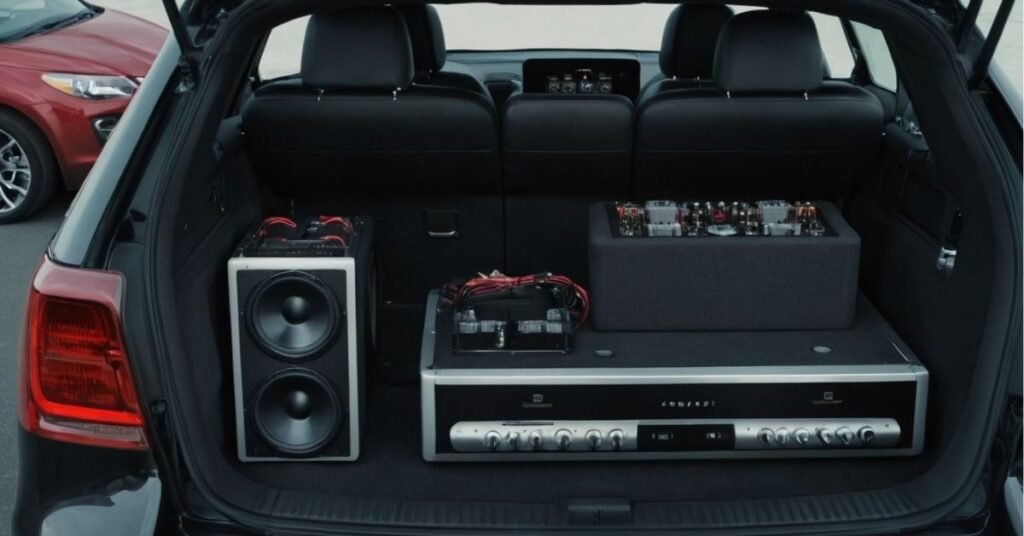Can I Run 2 Amps Off a Single Car Battery – The Truth Revealed!
Running two amplifiers off a single car battery can be challenging. If the combined current draw exceeds the battery’s capacity, it may cause overheating and performance issues.
Upgrading to a high-capacity battery or adding a second one can help manage the load effectively and ensure reliable operation.
Understanding Your Car Battery’s Capacity:
To determine whether your car battery can handle running two amplifiers simultaneously, you must first understand its capacity and how it relates to your electrical needs.
What is Ampere (Amp) and How Does It Relate to Your Battery?
The ampere, often abbreviated as amp, is a fundamental unit of electrical current. It measures the rate at which electricity flows through a conductor.
In the context of a car battery, the amp rating signifies the amount of current the battery can deliver. For instance, if an amplifier requires 15 amps to function, your battery must be capable of providing this amount of current without undue strain.
If the combined current draw of multiple devices exceeds the battery’s output, performance issues and potential damage may occur.
Battery Basics: How Car Batteries Are Rated?
Car batteries are typically rated by two critical metrics: amp-hours (Ah) and voltage. The amp-hour rating indicates the battery’s capacity to supply current over time.
For example, a battery rated at 60 Ah can theoretically deliver 1 ampere of current for 60 hours, or 2 amps for 30 hours.
Voltage, usually standardized at 12 volts for automotive batteries, provides the necessary electrical pressure to drive the current through the system.
Higher amp-hour ratings translate to greater capacity, allowing the battery to support more demanding electrical systems.
Also Read: Does Leaving USB Plugged in Car Drain Battery – Here’s
How Car Batteries Supply Power?
The ability of a car battery to supply power effectively hinges on several factors, including current flow and voltage stability.

Current Flow: How Car Batteries Distribute Amperage?
Car batteries supply power by distributing amperage through the electrical system. When you connect multiple devices, the battery must deliver the total current required by all devices.
If the current draw exceeds the battery’s output capacity, it can lead to overheating, reduced performance, and potential damage.
Proper understanding of how current flows and is managed within your vehicle’s electrical system is crucial for maintaining efficiency and safety.
The Importance of Battery Voltage in Running Multiple Devices:
Voltage plays a vital role in ensuring the smooth operation of multiple devices. Car batteries provide a constant voltage of 12 volts, which is necessary for the proper functioning of electrical components.
When running multiple high-current devices, it’s essential to maintain stable voltage levels to avoid fluctuations that can affect device performance.
Voltage drops or inconsistencies can lead to erratic behavior and reduced effectiveness of your amplifiers and other electronics.
Evaluating the Power Demands of Two Amps:
Before connecting two amplifiers to a single battery, it’s crucial to evaluate their combined power demands to ensure compatibility and avoid overloading.
How to Calculate the Total Amperage Needed?
To calculate the total amperage needed, sum the current draw of each amplifier. For instance, if each amplifier requires 10 amps, the total current demand is 20 amps.
This figure should be compared with the battery’s capacity to ensure it can handle the load. Accurate calculations help in determining whether your battery can provide sufficient power without risk of overloading.
Comparing Your Battery’s Capacity to Your Power Needs:
Compare the total amperage demand with your battery’s amp-hour rating to assess its suitability. For example, if your battery is rated at 50 Ah and the total current demand is 20 amps, the battery could theoretically support this load for 2.5 hours.
However, real-world factors such as battery health and efficiency can affect this calculation. It’s essential to consider these factors to ensure reliable performance and avoid potential issues.
Also Read: Car Alarm Goes Off When Charging Battery – Common Causes!
Risks of Running Two Amps Off a Single Car Battery:
Running two amplifiers off a single battery comes with inherent risks, primarily related to overloading and battery drain.

Potential Overload Issues and Battery Drain:
Overloading a battery by exceeding its current capacity can lead to significant issues. The battery may overheat, causing damage to both the battery and other electrical components.
Additionally, excessive current draw can quickly drain the battery, reducing its effectiveness and necessitating more frequent recharges or replacements.
Effects on Battery Life and Performance:
Frequent overloading can adversely affect the battery’s lifespan and overall performance. An overstressed battery may experience reduced capacity, shorter service life, and diminished reliability.
Proper management and avoidance of excessive loads are essential for maintaining battery health and ensuring consistent performance of your vehicle’s electrical system.
Alternative Solutions for Powering Multiple Amps:
If running two amplifiers off a single battery proves problematic, consider alternative solutions to manage power more effectively.
Using a Battery Isolator – Benefits and Drawbacks:
A battery isolator allows for the use of multiple batteries without them interfering with each other. This device ensures that one battery powers the amplifiers while the other supports the vehicle’s essential functions.
The benefits include improved battery management and reduced risk of overloading. However, using a battery isolator can add complexity and cost to your setup.
Upgrading Your Battery for Higher Amperage Needs:
Upgrading to a high-capacity battery designed to handle greater amperage demands can be an effective solution.
High-performance batteries offer enhanced load support and durability, reducing the risk of overloading and improving overall reliability.
This upgrade ensures that your battery can meet the demands of multiple high-current devices without compromising its health.
Also Read: What is the Advantage of 2.6 Volt Batteries in Series – The Power of Efficiency!
Practical Tips for Safe Power Management:
Effective power management is crucial for the safety and efficiency of your vehicle’s electrical system.

Monitoring Battery Voltage and Health:
Regularly monitor your battery’s voltage and overall health to ensure optimal performance. Check for signs of deterioration, such as reduced voltage or slow cranking.
Address any issues promptly to avoid performance problems and ensure reliable operation of your amplifiers and other electrical components.
Best Practices for Wiring and Installing Multiple Amps:
Ensure that amplifiers are installed and wired correctly to prevent potential issues. Use high-quality cables and connectors to minimize resistance and ensure efficient power distribution.
Proper installation techniques, including secure connections and appropriate fusing, are essential for maintaining safety and performance.
FAQ’s
1. Can I run two amplifiers off a single car battery?
Yes, but it’s crucial to ensure that the combined current draw of the amplifiers does not exceed the battery’s capacity. Overloading can cause performance issues and potential damage.
2. What factors affect whether my car battery can handle two amplifiers?
Key factors include the battery’s amp-hour (Ah) rating and the total current draw required by the amplifiers. Make sure the battery can supply enough current while maintaining stable voltage.
3. What are the risks of running two amplifiers on one battery?
Risks include overloading the battery, which can lead to overheating, reduced battery life, and performance issues. Excessive current draw may also drain the battery quickly.
4. How can I safely manage power when using multiple amplifiers?
Consider upgrading to a high-capacity battery, using a battery isolator, or ensuring proper wiring and installation practices. Regularly monitor the battery’s voltage and health to maintain performance.
5. What are some alternatives to running two amplifiers off a single battery?
Alternatives include installing a second battery, using a battery isolator, or upgrading to a high-capacity battery designed to handle higher amperage demands. These solutions can help manage power more effectively and prevent overloading.
Conclusion:
Running two amplifiers off a single car battery can be feasible, but it requires careful management of power demands. Ensure that the combined current draw of the amplifiers does not exceed the battery’s capacity to avoid overheating, reduced battery life, and performance issues. Consider upgrading to a high-capacity battery, using a battery isolator, or adding a second battery for better power management and reliability.
Don’t Forget to Read:














Post Comment